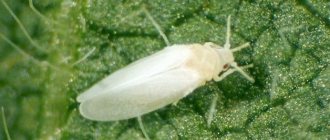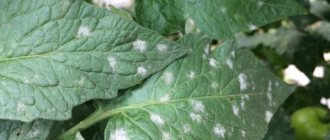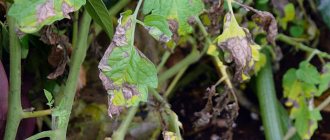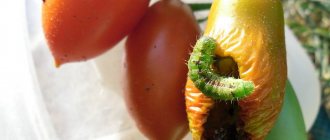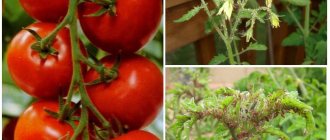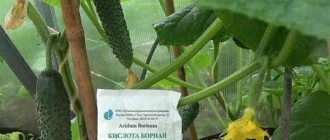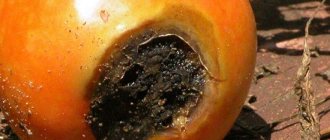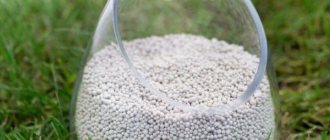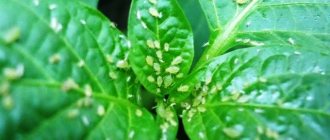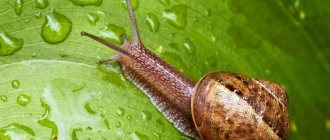What midges can harm tomatoes?
Anyone who has ever visited a garden knows that a huge number of different insects live there, but not all of them are safe for plants. Let's consider what kind of midges can be found on tomatoes both on open ground and in a greenhouse, and what harm they can cause to the future harvest.
Find out how to get rid of caterpillars on tomatoes.
Black
Another name for this pest is soil fly. Grows to a size of 4 mm. It reproduces in moist soil where organic fertilizers have been added. The larvae live in the top layer of soil, and after pupation they cause great harm by eating the roots of nearby plants. A large number of pests leads to oppression of plants, stunted growth and lack of fruits. Adult moths damage the growing point on tomato trunks.
White
They are small whitefly butterflies. Their body grows up to 3 mm. There is white dust on the wings. The larvae are deposited on the inside of plant leaves. Due to their life on stems and leaves, they are saturated with nutrients throughout their entire life. After this, the plant leaves become damaged and turn black. The same thing happens with fruits. Even a drop in temperature does not lead to the death of pests. They overwinter in the top layer of soil.
Folk methods of fighting midges
Perhaps every caring, self-respecting and concerned housewife has in her arsenal the answers to the question of how to get rid of midges using folk remedies. By adopting a specific recipe, you can make the fight against insects easier. The most popular methods are:
The so-called trap
You will need to place a piece of rotten fruit or vegetable in a small container. Cover the neck with cling film and make several holes around the perimeter. This trap is left in the kitchen overnight. After a flock of midges has collected in the container, pour boiling water over the contents, then you need to empty it near the trash container. By carrying out several such simple operations, you can rid yourself and your home of annoying midges.
Camphor
The most popular and effective method of controlling midges. Pieces of camphor are placed in a preheated frying pan. After steam appears, you need to walk around the room with the frying pan. Midges cannot tolerate the aroma of camphor and disappear as suddenly as they appeared. The method is particularly effective and is recommended by most experienced housewives.
Vacuum cleaner
Quite a simple, convenient way. Using a vacuum cleaner, midges are collected in a dust collector and released away from the living space.
Fragrance trap
Another effective way to get rid of annoying winged creatures. Pour an aromatic liquid into a container, preferably a jar. It could be wine, juice, coffee, fruit drink. Next, add dishwashing liquid and leave it indoors, preferably in the kitchen. The midges flock to the treat and, thanks to the detergent, die.
Orange and clove
Cloves are inserted into small punctures made in the orange. I leave this bait in the kitchen. Midges cannot tolerate such a fragrant union and die. The effectiveness of this method cannot be called excellent, but its use on the farm has its place.
Geranium
Everyone knows that geranium is a miracle remedy in the fight against moths. But few people know that it also saves from midges, which cannot stand the smell of the flower. By growing this plant on a kitchen windowsill, you can get rid of insects.
Vodka and vanillin
Midges cannot tolerate strong odors, so a solution of vodka and vanillin will repel insects. It is possible to spray areas of the skin with this mixture; in this interpretation, exposed areas of the body will be protected from insects.
Apples in a bag
Rotten apple cores are placed in a regular plastic bag. The midges will certainly gather in the bait, you just have to close the bag, tie it and throw it in the trash can.
Along with popular and well-known means of combating midges that are in the public domain, there are improvised ways to eliminate the problem. Any housewife should know how to get rid of midges using folk remedies. This will help, in the absence of the possibility of purchasing protective equipment in specialized stores, to eliminate unpleasant insects. Fortunately, improvised means are available in every home. By following the usual rules for storing food, you don’t have to think about the appearance of midges.
How to prevent midges from appearing in plants?
In fact, it is quite possible to prevent pests from appearing on seedlings without much effort. Try following these recommendations:
- Before planting the shoots, warm up the prepared soil in a microwave oven, this will ensure the most complete destruction of all pest larvae currently present in the ground;
- do not be afraid to use special insecticides along with fertilizers to combat parasites and harmful larvae - modern drugs are practically harmless to human health, so they will not cause you any harm;
- do not abuse fertilizers and excessive watering of the soil, since both of them lead to the creation of the most convenient and comfortable environment for the spread of pests;
- Clear the soil of fallen leaves in a timely manner and loosen the soil, so you can notice the reproduction of larvae at the very early stage.
If midges do appear in your plants, do not worry: at the initial stage of their appearance, eliminating pests will not be difficult, and further regular prevention of their appearance will help keep the shoots healthy and beautiful.
Signs of appearance
It is quite easy to detect the appearance of midges on tomatoes. The first thing that indicates the presence of this problem is small white butterflies that fly nearby. In addition, affected plants have other signs:
- leaves become curled and dry with a white coating;
- the stem and other green parts of the plant turn yellow;
- plants may reduce yield or even lose this ability;
- fruits ripen unevenly;
- ant trails are visible (ants feed on the waste products of midges).
The detection of even one sign should lead to the beginning of decisive action to save the plants.
Difference from black midge
Black aphid on a tomato leaf.
Black midge is popularly called aphid (Latin name laAphidoidea). This is one of the most common pests of all garden crops. Body length from 2.5-3 mm to 6–7 mm. On one plant there are both wingless and winged individuals.
Harmful aphids and whiteflies have much in common:
- Adults and larvae feed on the sap of the host plant.
- They quickly spread throughout the plant and increase the population.
- Sticky discharge.
- They carry dangerous bacterial and viral diseases.
Aphids always attract ants.
There are a number of differences:
- Aphids, which feed on sweet secretions.
- Aphids are found everywhere in open and closed ground; white midges are sensitive to temperature changes.
- Whiteflies spread in patches, while aphids spread en masse around them.
The main difference between whiteflies and aphids is the increased difficulty in destroying this pest on greenhouse tomatoes.
How to deal with midges on tomatoes
There are several ways to combat harmful insects:
- mechanical;
- chemical;
- folk
Let's look at all the methods for treating tomatoes in more detail.
Using chemicals
Garden insecticides provide an opportunity to get rid of parasites on the site in a short period of time. However, it is important to take into account that they contain substances that are hazardous to humans. The use of any chemical requires strict adherence to the instructions. In addition, before work it is important to take care of personal safety, namely: wear rubber gloves, safety glasses and a respirator. Let's consider what to spray tomatoes with when midges appear.
Important! It is best to use universal drugs that will help solve all problems at once.
Today the following insecticides are considered the most effective:
- " Decis forte " and " Decis pro ". Packaged in bags. Usually one is enough to process 2 acres, it all depends on the density of planting. The contents are dissolved in a bucket of water and the affected plants are treated with the resulting solution. It is recommended to do such manipulations only after sunset.
- " Inta-vir ". It is a universal insecticide, as it can be used to get rid of a huge number of pests. Prepare the solution as follows: 1 tablet is dissolved in 5 liters of water. This amount can process 30 square meters. m beds. This should be done when the plants are in the growing season.
- " Bio-raid ". It is a natural remedy because it contains plant substances. The drug in an amount of 5 ml is diluted in 2.5 liters of water. Spraying is carried out during the growing season with an interval of 10 days. On average, it is enough to spray the solution 3 times.
- " Aktofit ". The new generation product has become popular among gardeners due to its speed of action and safety for others. The ampoule is diluted in a bucket of water and treated with a plant solution. This can be done at any stage of growth. The last use is carried out 2 days before harvesting.
Using folk remedies
Knowing how to get rid of insects using chemicals, you need to know more gentle control methods. Apart from chemical remedies, you can get good results with homemade recipes. However, in this case, we should not forget that there are recipes that are strictly prohibited to be used during fruiting, since this can negatively affect the health of the person who has eaten the processed fruits.
Read more about how to feed tomatoes with yeast.
The most popular recipes include the following:
- Soap solution. For it, take a bucket of water and 1 laundry soap, which is grated and dissolved in the liquid. For greater effect, you can add 250 g of ash, which is first boiled in 1 liter of water for 20 minutes. This procedure can be done in the evening and only in calm weather.
- Tomato tops. Poison for small insects is prepared as follows: 1 kg of green tops is boiled in 2 liters of water for half an hour. Before applying to plants, the decoction is diluted in water in a ratio of 1:5.
- Tobacco decoction. Shag shavings in the amount of 500 g are poured with 100 ml of water and boiled over low heat for half an hour. The resulting and cooled solution is sprayed onto damaged plants.
Mechanically
Knowing what to do with midges using chemicals and folk remedies, we suggest learning about another method of control. The mechanical method is the easiest and most affordable, as it does not require additional funds or cash costs. However, it will be effective only when there are small numbers of aphids on the bushes.
Did you know? Growing tomatoes ranks first in the world. Every year, up to 177 million tons are collected. Most of them are grown in China, this figure is 30% of the world.
Pests are simply crushed with your fingers when inspecting plants. Finally, the bushes are doused with a strong stream of water to completely remove all insects. However, it is important to understand that this will not protect tomatoes from attacks by other pests.
Terms and rules for processing plants in an open area
Chemicals will help treat tomatoes against whiteflies. The eggs do not lose their viability, so spraying is repeated every one to two weeks. Chemical solutions are changed as insects adapt to the poisons. For complete destruction, it is necessary to comply with the terms and rules for processing plants.
Agrochemistry
All drugs are diluted in warm water. Before use, study the instructions.
| Name | Dosage | Mode of application | Processing times |
| Fitoverm | 4-8 ml per 1 l | Spray in dry, windless weather | every 10 days |
| Aktara | 1 g per 10 liters of water | Spray in the morning and evening in calm, dry weather. | every 7 - 14 days |
| Bioraid | 10 ml per 5 l | Sprayed | 2 – 3 times every 7 days |
| Verticillin G | 25 ml per 1 l | Sprayed | 1 time, repeat every other week |
| Decis Lux and Profi | 1-2 ml per 2 l | Processed | 2 times, repeat after 7 days |
| Karate Zeon | 2 ml per 2 l | Processed | 3-4 times every three days |
| Match | 3-5 g per 10 l | Sprayed | 1 time, can be repeated in a week |
| Fufanon | 1 ml per 1 l | Sprayed | once |
Important! In order not to poison the soil and the future harvest with chemicals, you must follow the rules for planting tomato seedlings.
- Fertilize the soil with wood ash.
- Before planting, inspect the seedlings.
- Plant at a distance of 50 cm from each other.
- Inspect the seedlings after 7 - 12 days.
- Conduct weed control in a timely manner, especially woodlice, sowweed and nettle.
- Carry out root treatment, hilling.
Processing seedlings
To prevent and protect the plant from whitefly, it is necessary to inspect and treat the seedlings.
- Onion infusion - chop the onion, 10 g of onion pulp is diluted with 1 liter of water. Leave for 5 hours, filter, water the soil.
- Spray with infusions with strong odors of garlic, orange, lemon.
- Coca-Cola is used as a fertilizer because of the minerals it contains, phosphoric acid and sugar. Add no more than 2 tbsp per 10 liters of water. l. drink Water the tomatoes right to the root. When sprayed, the insect will disappear due to the acidic environment.
Protection of bushes during flowering and fruiting
Do not use chemicals during flowering and fruiting of bushes and plants. It is impossible to wash the chemicals off the fruit. The use of poisons can poison beneficial insects: ladybugs, wasps, bees.
Natural ingredients will help protect against pests: fragrant infusions and soap solutions.
During flowering, you cannot prune bushes or shape tree crowns. Fertilizing with potassium humate will help protect against diseases and increase yield. The feeding process is divided into two times: during flowering and the second, when the formation of fruits and berries begins.
Boric acid is used to kill pests and feed fruit-bearing flora. Dissolve 10 g of powder in 10 liters of water. Spray in two stages: at the beginning of flowering and after its completion. Fertilizing is done once at the beginning of flowering, watered with a solution diluted in water 10 liters per 20 g of powder.
Autumn disinfestation
All measures for the prevention and destruction of whiteflies must be completed before the first sustained frost.
- Deep digging of soil mixed with wood ash in mid-autumn will be effective against pests that can easily tolerate cold weather.
- All plant remains, tops, weeds, and foliage are burned.
- Greenhouses are cleaned and disinfected.
- The top 10 cm layer of soil is changed or dug up. Disinfect with insecticidal preparations.
- Wooden floors are whitened with slaked lime in 500 g - 10 liters of water or painted.
- Kerosene cleans metal supports from moss and mold.
- The remaining auxiliary devices - rods, ropes - are treated with a strong solution of potassium permanganate.
- Glass and frames are cleaned with a brush and soapy water, from top to bottom.
- In some cases, you can use a bleach solution.
Preventive measures
In order not to lose the future harvest, you need to know how to prevent the appearance of pests:
- plant onions, garlic, calendula and other fragrant herbs near the tomatoes;
- Regularly remove weeds, as their shoots attract pests.
As can be seen from all of the above, fighting midge pests is not so difficult, the main thing is to identify them in time and choose the right remedy. Remember that some drugs are toxic, so you need to strictly follow the instructions so as not to cause even more harm to the plant.
Getting rid of midges
Under the influence of aphids, the leaves first curl, then turn yellow and fall off.
- In greenhouse tomatoes attacked by aphids, growth stops.
- The plant gradually withers, losing vitality.
- Many ants may appear around the bush.
You can prevent the invasion of aphids by placing marigolds, garlic, nasturtium, which exude a strong aroma next to vegetable crops.
Many gardeners plant marigolds in the greenhouse to repel pests.
Folk remedies
Folk remedies, at an early stage of damage, are not inferior in effectiveness to chemicals and can be used at any stage of plant development.
Chemicals
Chemicals are many times more effective, but more harmful to humans.
All chemicals can be used before bud formation; some drugs can accumulate in fruits, and if used untimely, can be harmful to human health.
Various insecticides and preparations are used against aphids: Karbofos, Aktara, Inta-vir, Iskra Zolotaya, Agravertin, Rovikurt, Confidor, Biotlin, etc.
If the population of aphids on a tomato bush is small, then you can simply wash the leaves of the plant.
Damage from black midges
Small black midges can have transparent wings or without them: both subspecies pose a danger to the future tomato harvest. Pests multiply quickly. They settle throughout the tomato bush, sucking the juices out of the plant. They move to neighboring bushes and infest the garden. Damaged bushes die. If you do not take measures to destroy insects, you may lose your harvest.
Prudent gardeners organize preventive measures to prevent black midges from reaching seedlings or adult tomatoes. Plant fragrant herbs next to the tomatoes that attract insects dangerous to the parasite:
- os;
- lacewing;
- hover flies;
- ladybugs.
In addition to fragrant herbs, onions, garlic, calendula, and dill are planted. The midge does not like the smell of these plants. Eliminate weeds thoroughly: the parasitic insect feeds on tomato juice and likes to settle on weed shoots.
Get rid of anthills on the site. Ants protect aphids by feeding on the sweet secretions they secrete.
Preventative measures have not helped, and black midges are covering more and more bushes? Start exterminating the parasites immediately!
How to get rid of midges in tomatoes. How to treat tomatoes against midges
When fighting black midges, it is not enough to treat only adult individuals.
It must be remembered that the larvae hide in the soil, between the roots. To get rid of them and prevent the appearance of new flies, you need to treat not only the tomato bush, but also the soil in the circle around the trunk. To combat the larvae, “Bazudin” granules, the protection of which lasts about 6 weeks, or “Grom-2” are dropped into the top layer of soil around the plant. Its effect is longer - up to two months.
To distribute the granules evenly, they are mixed with coarse dry sand. The application dose per plant, or per 10 sq.m., is written on the packaging. Distribute at a depth of 2 cm, sprinkle with soil. The first time after application, the tomatoes are not watered.
To destroy flying individuals of fungus gnats and whiteflies, the same means are used.
The easiest way to combat midges is with systemic preparations that are absorbed by all parts of the plant. The impact on pests occurs when an insect lands on the leaves and begins to drink juice from them. It is effective even when some time has passed after spraying.
Systemic insecticides should not be used if there are less than 25-30 days left before harvest. Chemicals get into the fruits and do not decompose for a long time, and this is dangerous for humans.
In such cases, it is better to use enteric contact drugs: “Aktara”, “Decis-pro”. They are not phytotoxic to tomatoes and contain fast-acting substances.
Safer are products that contain substances of biological origin. For example, “Fitoverm” - tomatoes can be harvested two days after treatment, it is safe for the environment and quickly decomposes in the soil.
When re-treating whiteflies, you should change insecticides, because these butterflies develop immunity to the same pesticides.
Treatment of tomatoes against midges is carried out in dry weather, in the morning or evening hours. Treatment in bright sunshine is not carried out for two reasons:
- causes leaf burn;
- the drug quickly evaporates from the surface of the leaf, without having time to affect the pest.
We fight insects using traditional methods
Cold air is one of the pest control methods. Harmful insects do not like low temperatures. Therefore, if possible, take the tomatoes out into the cold. A glue-based trap also gives a good effect.
Use pieces of plywood that have been pre-painted yellow. Spread them with glue, and the insects will not keep you waiting. They will be attracted to the bright color and will stick. Regular adhesive fly tape will also work for this. Try rubbing tomato leaves with various herbs, for example, yarrow, or a solution of laundry soap, tincture of garlic, or just clean water. The latter is suitable only in the fight against adult insects.
